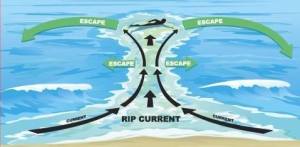Water Safety
The weather is hot and COVID-19 restrictions have eased which means more and more people are getting out to take advantage of all of Nova Scotia’s beautiful lake and ocean beaches. With July 19-25, 2020 being the Lifesaving Society of Nova Scotia’s Drowning Prevention Week, now seems a good time to provide some basic water safety reminders.
Beach Safety
A day at the beach is good for the soul, but the body must be mindful of potentially dangerous ocean currents.
Stay inside the flags!
All Provincial beaches supervised by the Nova Scotia Lifeguard Service (NSLS) use an internationally recognized lifesaving flag system with red and yellow flags used to identify the safest areas within which to swim. When you do swim, stay inside the flags. They’re there to protect you. The flagged area is supervised by a professional trained lifeguard within operational hours during the summer months. Lifeguards set up the flags in the least dangerous area on the beach where no rips or other hazards are present, and jetskis, seadoos, surfers, kayaks and other such craft are not permitted to travel between the red and yellow flags, keeping the area clear for swimmers to enjoy.
Powerful Ocean Currents
Nova Scotia experiences some of the most powerful surf on the Eastern seaboard and this, coupled with our short summer season, can mean many people out enjoying our beaches don’t know what to be aware of. When bobbing in the ocean waves, be mindful of rip currents. Movement of water coming onto the beach from waves can cause rip currents – also known as rip tides, undertow, wash or run out. After washing ashore, gravity forces water to return to the sea. Depending on a number of factors including the force of the waves, beach conditions, and the location of sandbars under the water’s surface, the returning water can accumulate in one area causing a strong current at an isolated area of beach. Rip currents can stay in the same place for long periods of time, travel along the length of the beach, or suddenly open up at any time or location along the beach.
Some signs to look out for:
- Waves breaking further out on either side of the rip
- Discolored water caused by the turning up of the sand
- Rippled appearance where the water is calm
If you get caught in a rip current, DON’T PANIC! Here are some tips to get you safely back to shore:

- Don’t fight the current, you won’t win. Swim parallel to shore until you have bypassed the rip current – approximately 30 meters – then adjust course and return to shore.
- If the current is too strong for you to navigate on your own and you require assistance from a lifeguard raise one of your arms straight directly above your head.
Tide and Surf Awareness
Late summer/early fall is the time when our ocean beaches experience their strongest surf patterns. This is caused by heavy storm activity during the Atlantic hurricane season. Swimmers and surfers are urged to be extra cautious in these periods of storm surge and heavy surf.
Lake Safety
Lake beaches are another way to enjoy Nova Scotia’s glorious summers. As always, swim at a supervised beach and stay within the flags. The NSLS also supervises lakeside swimming. Look before you leap – shallow water, underwater tree debris, logs or big rocks can all be dangerous when diving into lakes or swimming holes. Only dive into areas where it is safe to do so and always obey no diving signs. Always check your surroundings and enter the water slowly, feet first. Lakes can have uneven floors and sudden drop offs. Stay within your abilities. Swim only where you feel comfortable, follow the buddy system and go with a friend, and wear a personal flotation device. Don’t underestimate the effect that cold water and rough conditions can have on both your ability to swim and your stamina level. Water quality is another factor to consider before setting out to enjoy a lazy lakeside day. HRM monitors the water quality at its municipal beaches. They also monitor other hazards, like blue green algae and provide information to the public to help assist you in making informed decisions before you head out for some fun in the sun. Go to halifax.ca for up to date information or check your own municipality for local information. Following basic safety guidelines will help keep your summertime surf activities fun! And remember – ALWAYS WEAR SUNSCREEN!
In case of any boating accidents or injuries, make sure to give us a call at 1-800-465-8794 and our experienced team members at Wagners Law Firm will evaluate and review your case for compensation.

